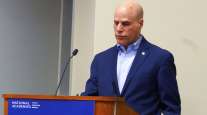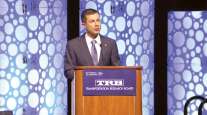Staff Reporter
Metropolitan Leaders Discuss Congestion Pricing Challenges, Solutions

[Stay on top of transportation news: Get TTNews in your inbox.]
WASHINGTON — Transportation leaders identified outreach and education as tools that can help bridge the “trust gap” between communities and congestion pricing.
Tilly Chang, executive director of the San Francisco County Transportation Authority, and her team have led numerous outreach efforts as they work on an updated congestion pricing study. She said downtown San Francisco’s congestion is a byproduct of the city’s “hot economy” and lack of affordable housing. Chang spoke before a packed room of attendees, who included public and private sector representatives and students, at the Transportation Research Board’s annual meeting Jan. 12.
The transportation authority convened a 35-member Policy Advisory Committee made up of community stakeholders, hosts one-on-one listening sessions and meets with community-based organizations to get a sense of people's various transportation experiences.
ALSO AT TRB: Metropolitan Planners Encouraged to ‘Go Out in the Field’
“It’s not rocket science, but having the time and the resources and the space and the right people around the table to have those early conversations, we hope will build trust,” Chang said. “There is a trust gap, at least in San Francisco, with this topic. I think in the U.S. in general we struggle. People here feel very much more vulnerable.”
Chang said equity analysis will be a key component of the study, noting that communities vary based on income and auto ownership.
“Congestion affects everyone, particularly the vulnerable groups,” Chang said.
Southern California, too, has an eye toward congestion pricing. In September, the board of directors for the Los Angeles County Metropolitan Transportation Authority approved two contracts to conduct a feasibility study evaluating the possibility of congestion pricing in the area.
Phillip Washington, CEO of the Los Angeles County Metropolitan Transportation Authority, explained the goal of the study is to identify both a potential pilot test area and the best model to implement in that pilot area.
“Within that pilot area, we have to convince that pilot area that they’ve won the grand prize,” Washington said. “I believe, within that pilot area, traffic will flow a lot smoother [and] commute times will be reduced.”
Congestion in Los Angeles County, which is home to over 10 million residents, has reached a “crisis level,” according to Washington. In the American Transportation Research Institute’s truck bottlenecks report unveiled last February, Los Angeles had three intersections ranked in the nation’s top 50.
Getting underway with a full house of international speakers and nifty instant polling at #TRBAM2020 Cross-Cutting Issues in Urban Congestion Pricing (Wkshp 1047) Room 151A. https://t.co/I8VKb5zpJW pic.twitter.com/ghdB6xOktB — Tilly Chang (@tilly_chang) January 12, 2020
Washington, who calls the system “decongestion pricing,” said the program can gradually reduce — and possibly even eliminate — transit costs for commuters in the pilot area and later the entire county.
“We believe that we can use the revenue generated from decongestion pricing to make transit free for everyone,” Washington said.
Washington and Chang spoke alongside various transportation officials, several of whom represented countries that had pursued congestion pricing programs.
Luke Blair, who managed media relations for central London’s congestion pricing program, said most opposition to the charge system eventually diminished. He said his team’s media strategy involved advertisements that were simple and factual, and the team conducted opinion polls before and after the program went live in February 2003.
Mattias Lundberg, who leads the City of Stockholm’s Department for Transport Planning, said public acceptance of the city’s cordon pricing system eventually increased. Cordon pricing means charging a vehicle that crosses a boundary into a pricing zone. Stockholm’s system, which has been in place since 2007, resulted in 20% less traffic.
Want more news? Listen to today's daily briefing:




